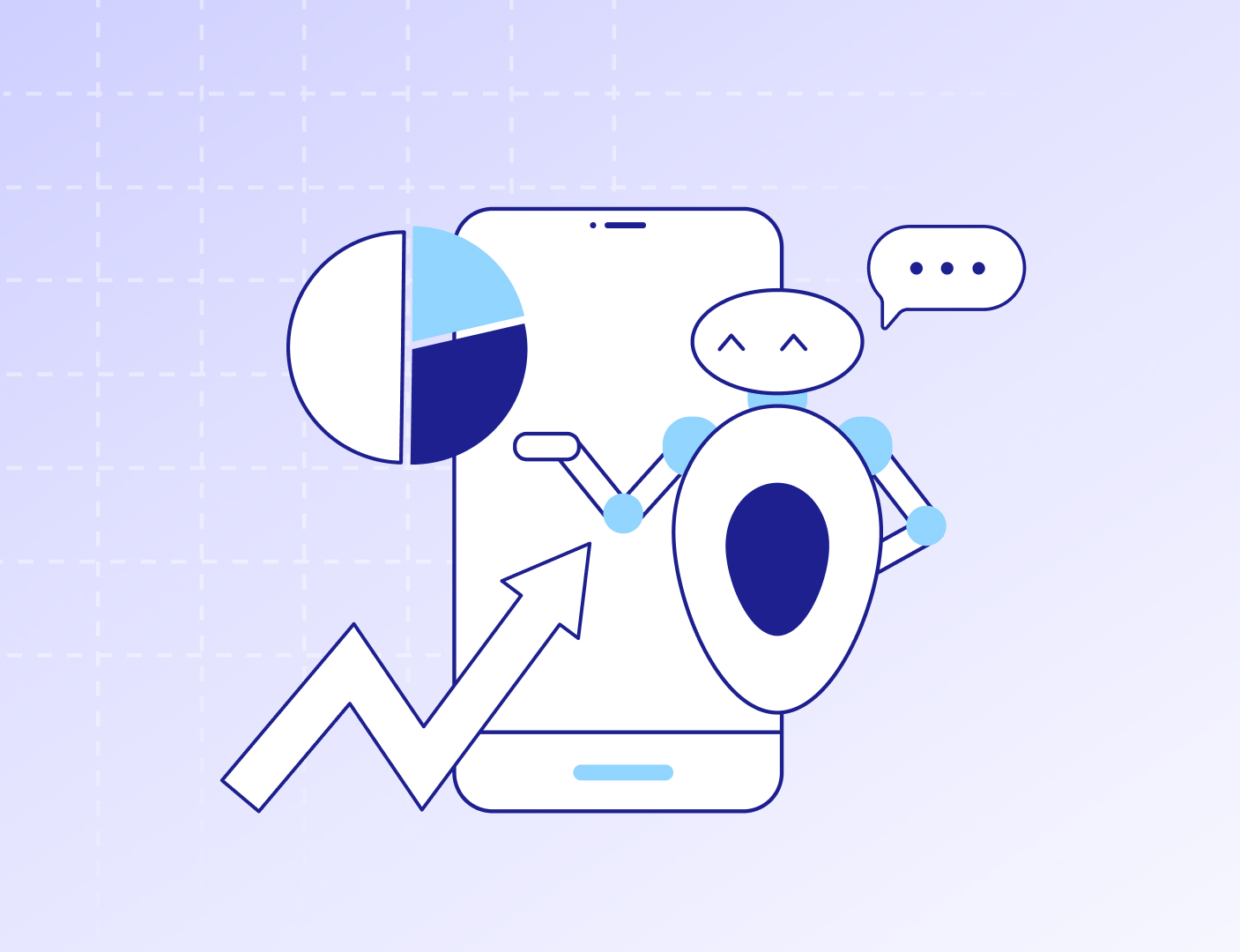In a nutshell:
- Artificial intelligence (AI) has revolutionized marketing by helping marketers connect with their target audiences, measure campaign performance, and create personalized experiences.
- Generative AI focuses on content generation, while predictive AI makes accurate predictions based on historical data.
- Generative AI can automate content creation and save marketers time, but it may lack quality and relevance.
- Predictive AI provides actionable insights for marketing strategies and optimization, but its predictions require human interpretation and expertise.
- Both generative AI and predictive AI have their strengths and limitations, and using them together can maximize marketing effectiveness.
There's no denying that technology has helped marketers more effectively connect with their target audiences, measure campaign performance, and create personalized experiences that resonate with consumers. At the heart of today's growth opportunity lies artificial intelligence (AI), most prominently: generative AI and predictive AI.
But what do those terms mean? How do they work? Are they worthy of your budget? And most importantly, is one better than the other? This article explores the differences between these two types of AI, their applications for marketers, and why you should consider using them both for maximum marketing superpowers.
What is AI, anyway?
Before getting into the nitty gritty of generative AI vs. predictive AI, it's essential to understand artificial intelligence (AI) clearly.
AI is a broad classification of technologies (machines, systems, or software) that can perform tasks that resemble human intelligence. These tasks include things like learning, reasoning, problem-solving, and decision-making. AI's applications span across various sectors, where its applications become increasingly specialized, like predicting customer churn and customer lifetime value in marketing. (We’ve compiled a list of the top 10 AI tools in marketing.)
According to Grand View Research, the AI market is projected to experience an annual growth rate of 37.3% between 2023 and 2030. This substantial growth underscores the escalating influence of AI technologies in the years ahead.
Get started today and let your data drive results in weeks
There’s no “AI” in marketing (but there is in campaign, retail, email, and gains)
Now let’s take the role of AI in marketing. Marketers face the critical responsibility of continually building and launching effective campaigns — and then proving those campaigns' return on investment (ROI). According to a 2022 Forrester report, 71% of B2C marketing leaders struggle to prove the value of their marketing efforts to key decision-makers such as the CEO, CFO, and board members.
AI enhances what marketers can do on their own — kind of like superpowers. Depending on the type, AI can automate manual and repetitive tasks, track customer activity, provide predictive insights into campaign performance, and even create new content in seconds. All of this frees up marketers’ time to focus on the strategic work they do best and boost ROI, whether that’s planning marketing strategies, meeting with key stakeholders, or just generally doing the human-powered tasks AI can’t replicate.
So, which type of AI is best for your team?
The difference between predictive and generative AI is: Generative AI creates content, code, music, and marketing materials, while predictive AI makes predictions, recommendations, and decisions using AI and machine learning techniques.
But let's dig deeper to understand these technologies fully.
What is generative AI?
In the simplest terms, generative AI focuses on “generating” content. Whether it's crafting text or producing images, generative AI is the data-driven engine behind these endeavors, playing the role of writer or artist. When it comes to text-based content, prominent generative AI models like Google Bard, ChatGPT, and Bing Chat have made significant strides in creating high-quality responses. Tools like DALL-E and Midjourney have also gained recognition for their remarkable image-generation capabilities.
How does generative AI work?
Solutions like ChatGPT are built using large language models (LLMs). These models use natural language processing (NLP) algorithms to understand your “input” and “generate” outputs, whether that’s code, text, or multimedia. Even though it feels like magic, it follows a step-by-step process.
First, generative AI models are trained. They analyze vast datasets and begin to discern relationships and patterns in the training data. All of this information is stored within the AI model’s neural network, which acts like a human brain. Once training is complete, the generative AI model can start generating content. It’s given a starting point or some input and uses the patterns it learned to guess what comes next. Think of it as a person with an amazing memory and never-ending access to books and pictures, which helps it make up its own stories.
Managing a generative AI model requires continuous development to ensure content is helpful, accurate, and diverse. Through fine-tuning and sampling processes, generative AI can automate content creation and deliver personalized, engaging experiences for various marketing applications.
Why is generative AI useful for marketers?
Have you ever had to write a blog post only to find yourself staring at a blank screen for hours? Generative AI takes on many time-consuming tasks (like generating blog outlines) and, simply put, creates something for you. It’s like a helpful assistant for marketers — that never burns out.
It can help brainstorm new ideas for headlines, create new content (like blogs and social media posts), craft personalized messages (like emails), and even design graphics for your different content pieces, making the marketing process faster and more efficient.
With generative AI, marketers can develop new content much faster than on their own — whether that’s having generative AI do all the work or just using it to get those creative juices flowing. In fact, generative AI is such a time-saver that marketers estimate it can free up as much as a month's worth of their time each year.
Marketers believe generative AI can save them more than 5 hours weekly on tasks, which adds up to more than a month's worth of time saved each year.
— Salesforce
Generative AI for marketing excels at:
- Content Generation: Creating relevant text-based content at scale, saving time and resources.
- Personalization: Customizing marketing messages and content for different customer segments.
- Creative Assets: Developing visual and multimedia content for visually appealing campaigns.
What are the limitations of generative AI in marketing?
While generative AI proves to be a valuable asset for marketers, it comes with limitations. First and foremost, generative AI heavily relies on its training data, which may not always perfectly align with marketing requirements. This can result in content that falls short in terms of quality and relevance. Additionally, generative AI has been known to produce misinformation, a concern shared by most consumers.
In addition, generative models are unable to make sense of raw transactional or tabular data, which is a key concern for marketers considering how much marketing data is stored in spreadsheets. This limits access to insights from data points such as customer interactions, purchase history, behavior patterns, and the like. Consequently, it lacks the inherent capacity to predict future trends or outcomes, which are crucial for effective customer targeting and campaign optimization.
Over 75% of consumers express concerns about misinformation from artificial intelligence (AI) tools like Google Bard, ChatGPT, and Bing Chat.
— Forbes
Furthermore, generative AI may struggle to generate genuinely innovative or creative marketing ideas due to its inability to perform data preprocessing or construct predictive models. It operates within the boundaries of existing data patterns, potentially lacking the inherent creativity to design exceptionally unique or groundbreaking marketing campaigns.
The limitations of generative AI for marketing include:
- Unpredictable Quality: Potential issues with content quality or relevance due to its reliance on training data.
- Inability to Process Tabular Data: The inability to analyze tabular data, often stored in spreadsheets, limits access to valuable insights.
- Lack of Innovation: Operating solely within existing data patterns may hinder the generation of creative and forward-looking marketing ideas.
What is predictive AI?
Predictive AI, also known as predictive analytics, builds models capable of making accurate predictions or forecasts based on historical data and patterns. It’s like a crystal ball for businesses — except, instead of extrasensory perception (ESP) and translucent rock, it relies on huge amounts of data and (usually cloud-based) servers with tremendous processing power.
Predictive analytics lets companies anticipate future trends, behaviors, or outcomes. Pecan AI, for example, uses predictive AI to help marketing, business intelligence, operations, and revenue teams predict outcomes about their campaigns, customers, and supply chains. Other platforms like HubSpot incorporate predictive AI capabilities to assist with tasks like customer segmentation.
How does predictive AI work?
Predictive AI begins by ingesting specific data, such as past customer interactions, like clues for predicting future events. These data sets are then cleaned, joined, and meticulously organized, ensuring clarity and alignment in the analysis. (By the way, Pecan does this automatically, even if the input data is messy!)
And just like there are different knives for different purposes (please don’t try to debone a fish with a cheese knife), end users can use different models — statistical algorithms — for specific tasks. Once identified, this model undergoes training to recognize patterns in the data, enabling it to provide relevant predictions that address burning business questions.
It's essential to understand that predictive AI is not static; it adapts to evolving business conditions. Well-maintained models adjust to changing patterns in the data, ensuring the continued accuracy of their predictions over time.
Predictive AI is widely used across industries like finance, retail, healthcare, and more to forecast customer demand, optimize operations, and detect fraud. Notably, it serves as a powerful partner for marketers in all industries.
Why is predictive AI important for marketing?
While generative AI can offer guidance related to predictive analytics or help data scientists write code, marketers need more accessible solutions in many scenarios to make predictions. Consider those seeking to identify high-churn-risk customers, construct sophisticated customer-journey maps, or boost campaign performance and return on ad spend (ROAS).
Predictive analytics uses your historical data to give you actionable insights to shape overarching strategies, optimize your marketing budget, and fine-tune campaigns. Moreover, predictive AI excels in churn anticipation, preempting customer departures and facilitating proactive retention strategies. By bridging the gap between guesswork and data-driven decisions, predictive AI enables marketers to understand, serve, and reach their customers more effectively. Today, over 60% of business owners already believe that AI will elevate customer relationships, a number destined to rise.
64% of business owners express optimism about AI’s potential to improve customer relationships.
— Forbes
Predictive AI for marketing excels at:
- Customer Segmentation: Identifying customer segments with unique preferences and behaviors, enhancing marketing campaigns.
- Lead Scoring: Assessing lead conversion likelihood, aiding resource allocation.
- Churn Prediction: Forecasting customer churn, informing retention strategies.
- Marketing ROI Optimization: Allocating marketing budgets effectively by predicting strategy outcomes.
What are the limitations of predictive AI in marketing?
Like any tool, predictive AI has its own set of shortcomings. While its strengths are in forecasting trends and future outcomes, it lacks the creativity and content-generation capabilities of generative AI.
Additionally, developing and maintaining predictive AI models can be resource-intensive. It can demand a long list of requirements: skilled data scientists or analysts, access to high-quality data, substantial computational resources, and ongoing model maintenance. Nevertheless, modern predictive AI platforms like Pecan AI are designed to help marketers and non-technical team members build predictive models in minutes and without expert data scientists.
While predictive AI provides valuable insights, it typically relies on human expertise to translate them into actionable marketing strategies and creative campaigns. Marketers still play a crucial role in interpreting and implementing the predictions effectively.
The limitations of predictive AI for marketing include:
- Lacks Creativity: Doesn't possess creative or content-generation capabilities.
- Resource-Intensive: Traditional predictive analytics demands skilled data scientists for ongoing model maintenance.
- Requires Human Guidance and Interpretation: Relies on human expertise to translate insights into actionable advertising strategies and creative campaigns.
Generative AI vs. Predictive AI: It’s Time To Join Forces
While it might be entertaining to envision a showdown between generative AI vs. predictive AI, the reality is that these two technologies complement each other exceptionally well. Generative AI excels in creative content generation, while predictive AI empowers data-driven decision-making to improve distribution and attribution and inform future content generation.
In essence, it's not a matter of choosing between these technologies but instead selecting the right tools that align with your marketing objectives and budget. This approach ensures that you remain ahead in the AI race. So, choose wisely — and put the “AI” in “ROI” (we tried our best to make that work!).
Interested in discovering how generative AI and predictive AI can work together to skyrocket your marketing goals? Book a demo with us today.





